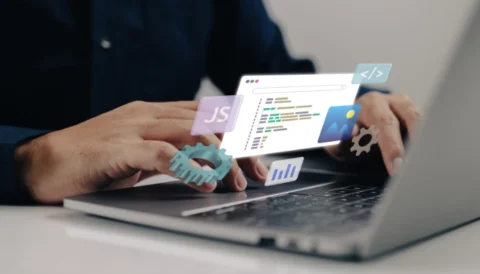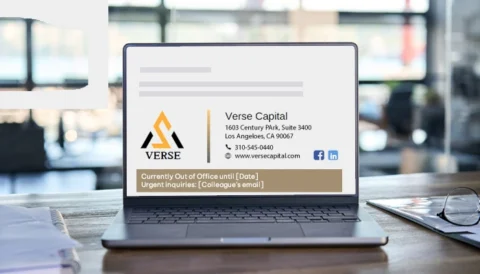
Is ‘Best’ always the best email sign off? Your closing words can shape how your message lands. And just like a strong email intro, a thoughtful outro matters more than you might think.. So while there are only a handful of ways to say ‘Hi’, there are so many different ways to sign off an email that choosing the correct email ending can be confusing. From the formal ‘Yours sincerely’ to the casual ‘Cheers’, using the right business email sign off can make a real difference to your recipient’s reaction and the response you’ll receive.
You’re too busy to waste time worrying about how to sign off every email correctly. That’s why we’ve produced this guide to help you choose the most appropriate sign off for any email. You’ll learn how to look professional without appearing pretentious, friendly without being over familiar, and creative enough to stand out from the crowd. With our best practice business email sign off examples you’ll always make the right impression.
In this email sign off guide, I’ll show you:
What are email sign offs?
An email sign off is simply the short (usually two or three word) phrase that you use to end your email message before adding your name and email signature. It’s as simple as that. So simple that most people don’t give a second thought to how they end their emails. Even people with full professional email signatures say ‘But how do I sign off an email?’. Stand out from the crowd by leaving the right impression – and getting the right response – by always using the right email sign-off.
How should you sign off an email?
Unlike formal letter writing’s traditional sign offs of ‘Yours faithfully’ or ‘Yours sincerely’, there are no rules for signing off an email. You have to use your judgement and choose the most appropriate email sign off for the situation. There are, however, some email sign off best practices to help you make the right choice. Let’s take a look…
Email sign off best practices
When choosing an email sign off, follow these best practices:
- Match the Context: Align your sign off with the email’s tone. Use formal email endings for professional messages and relaxed endings for casual ones.
- Consider the Relationship: Tailor your sign off based on your relationship with the recipient. Use “Best regards” for clients and “Cheers” email sign off for colleagues.
- Be Respectful: Always choose a respectful email sign off. “Best wishes” works well across various cultures and generations.
- Check Punctuation and Spelling: Capitalize only the first word (“Kind regards” not “Kind Regards”). Avoid spelling mistakes.
- Signing off emails with an AI email writer: To ensure the perfect sign-off, consider automating your email copywriting with AI tools like HubSpot’s AI email writer, Qozex’s AI email generator or Editpad’s AI email writer. By selecting and customizing email templates with AI-generated content, you can craft emails that are perfectly suited to your audience, including the ideal sign-off. This approach not only saves you a significant amount of time but also eliminates the frustration of staring at a blank draft, unsure of how to start!
- Personalize When Appropriate: Add personality once you have a friendly relationship with the recipient. Stay professional but personable.
- Be Cautious with Creativity: Creative email sign offs may not be universally understood. Ensure your sign off is clear and appropriate.
- Stay On-Brand: Use a sign off that reflects your company’s image. Implement centrally controlled email signatures for consistency.
- Use Emojis Sparingly: Emojis can add humor but use them cautiously. Ensure they convey the intended message.
- Play It Safe: If unsure, opt for a neutral sign off like “Regards” to avoid appearing unprofessional.
- Mirror the Sender’s Sign Off: When replying, match the original sender’s sign off if appropriate.
Following these guidelines ensures your email sign offs are professional, respectful, and brand-aligned.
As Sean Butcher, Founder of Reflect Consultancy notes:
“Firstly, really consider your audience. Is it a large corporate or a small startup? Do you have a previous relationship with the person you are emailing or are you prospecting a cold lead? Are other people you don’t know so well cc’d (or could they potentially be bcc’d in the email thread) and therefore you’re exposing yourself to more people that could judge the way you are communicating?
If you have a pre-established relationship with your contact then it’s more likely you can incorporate a bit more flexibility in the way you exchange emails. Though for those people you don’t know, it’s best to start with an element of formality, and at the very least, general politeness in your tone.
Even then, whilst most people can accept a bit of ‘banter’, there’s a fine line between ‘jokey’ and ‘offensive’. Unless you are the very best of friends, you never know someone’s circumstances, personal situation or history. It doesn’t take any effort to be courteous, professional and polite, and people will remember you for it.
As a general rule: if there’s any doubt about your email sign-off’s appropriateness, or if you are in any way concerned that it could be deemed risky, then it’s always best to trust your gut and play it safe.”
Which email sign-off delivers the highest response rates?
Boomerang conducted a study and proved that a little thanks goes a long way. They looked at closings on 350,000 emails and found that gratitude sign-offs received the highest response rate.
‘Thanks in advance’ came up on top with a 65.7% response rate, followed closely by ‘Thanks’ at 63% and finally a 57.9% response rate for ‘Thank you’.
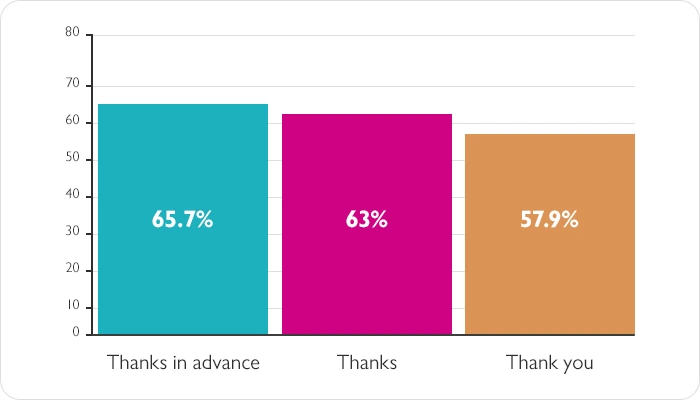
Professional email sign offs
Learn how to sign off an email professionally with these top examples:
- Sincerely / Yours sincerely: Ideal for formal business and legal emails.
- Regards / Best regards / Kind regards: Safe and professional choices.
- Respectfully / Yours respectfully: Suited for senior executives or officials.
- Best wishes: Formal yet friendly, with a personal touch.
- Best: Short, extendable to ‘Best wishes’,’Best regards’ or ‘All the best’
- Thank you: Neutral email sign off and universally appropriate.
These professional email sign off examples ensure you leave a positive impression in the workplace.
Choosing a traditional email sign off, such as ‘Best regards’ might sound like playing it safe but in many ways it makes perfect sense. No one ever got reprimanded for being too professional!
‘Best wishes’ keeps things formal but it’s also friendly, professional but with a more personal feel – a universal email sign off. ‘Best’ has become a very popular go-to email sign off choice, but does it look dull? You can always extend it to a ‘Best wishes’, ‘Best regards’ or make it an ‘All the best’ email sign off . ‘Thank you’ is another neutral email sign off that works in almost every situation, making you look professional and polite.
Whatever email ending you choose, a professional email signature perfectly complements a professional email sign off to leave the right impression on the recipient. This professional approach is most effective when you reach the right contacts, where an email finder proves invaluable.
Work friendly email sign off
Using a casual email sign off can help build friendly relationships in a less formal business world. Here are some suggestions:
- Warm and Friendly: “Warmest regards,” “Warmly,” “Cheers!”
- Express Gratitude: “Thanks,” “Many thanks,” “Thanks so much.”
- Encourage Communication: “Looking forward to hearing from you,” “Talk soon.”
- Personalize: Use your first name or a nickname.
- Stay Professional: “Best,” “Take care,” “All the best.”
- Add a Personal Touch: “Best wishes,” “Enjoy your day,” “Have a great week.”
These casual email sign offs can maintain professionalism while creating a friendly tone.
Funny email sign offs
Email sign offs don’t have to be serious. Adding a humorous email sign off can raise a smile, but use them with close colleagues and customers you know well. Here are some funny email sign off examples:
- See you later, alligator!
- Thank goodness it’s Friday!
- Catch you on the flip side
- And that’s a wrap!
- Stay awesome!
- Don’t do anything I wouldn’t do!
- May the force be with you
- Keep on rockin’!
- To infinity and beyond!
- Hakuna Matata!
These funny email sign offs can add a touch of humor and personality to your messages, making them memorable and enjoyable.
Creative email sign offs
A creative email sign off can make your message memorable, especially if it includes popular culture references. Ensure the recipient will appreciate the reference. Here are some creative email sign off examples:
- To infinity and beyond!
- Hasta la vista, baby!
- Live long and prosper
- May the force be with you
- Yabba Dabba Doo!
- Stay magical!
- Keep on shining!
- Adventure awaits!
- Stay curious!
- Carpe Diem!
These creative email sign offs can add a personal touch and make your emails stand out. Just remember, they might only seem creative the first time the recipient reads them!
Email sign offs to avoid
When it comes to email endings to avoid, follow these guidelines to maintain professionalism:
- Avoid Being Too Formal: Overly formal email sign offs like “Yours faithfully” and “Yours respectfully” can come across as pompous rather than professional.
- Avoid Emotional Sign Offs: Affectionate endings like “Love,” “Lots of love,” or “Hugs” are inappropriate for the workplace and should be reserved for personal relationships.
- Avoid Abbreviations: Email sign offs like “Thx,” “XO,” “L8r,” “TTYL,” and “Rgrds” appear lazy and unprofessional. They might also confuse recipients.
- Avoid Offensive Language: Never use swearing or offensive language in your email sign offs.
- Avoid Religious or Political References: Steer clear of religious blessings or political statements in your sign offs to maintain neutrality.
- Avoid Leaving Out a Sign Off: Not using a sign off at all can seem rude and abrupt. Always include a courteous sign off, especially in the initial email of a conversation.
- Avoid Just Signing Your Name: Simply using your name as a sign off is brief and blunt. It’s not suitable for introductory emails but might be acceptable in ongoing email chains.
- Avoid Passive-Aggressive Sign Offs: Phrases like “Kind regards” can sometimes be perceived as passive-aggressive (and not kind at all!). Ensure your sign off reflects genuine sentiment.
By avoiding these email endings, you can ensure your email communications remain professional and courteous.
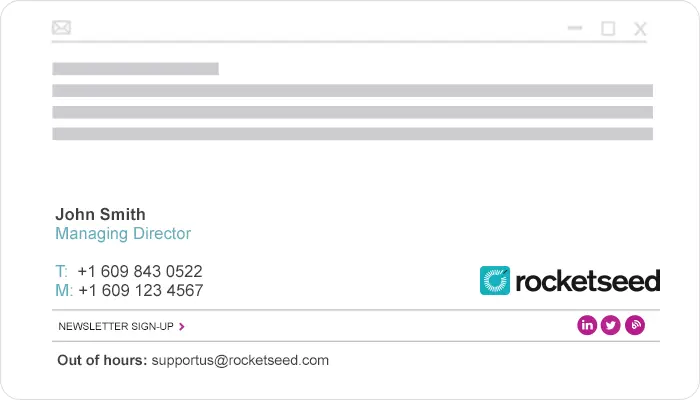
Passive aggressive email sign offs
Spotting the most passive-aggressive phrases in workplace email sign offs can help maintain a positive work environment. Here are some common examples and their interpretations:
- Regards – (I really can’t be bothered to be at all friendly)
- Awaiting your response – (I need the information NOW – hurry up!)
- Any updates on this? – (What’s taking you so long?)
- Please advise – (It’s your problem now, not mine – deal with it)
- Thanks in advance – (You can’t get out of helping me now)
- I look forward to hearing from you – (Get back to me quicker than you did last time)
- All the best – (You won’t be hearing from me again)
Recognizing a passive-aggressive email sign off can improve communication and productivity. Addressing these behaviors can foster a more positive workplace environment.
Generational differences email sign offs
What does a GenZ email sign off look like? As Saman Javed, writing in The Independent reveals, Gen Z are signing off workplace emails in remarkably different ways from traditional formalities.
So while older generations play it safe with classic email sign offs such as ‘Kind regards’, ‘Best wishes’, ‘Sincerely’ and ‘Thanks’, the GenZ sign-off examples cited include ‘That’s all’, ‘Hehe, bye’, ‘Alright alright alright’, ‘Hasta la pasta’, ‘Insert pleasantry here’, ‘Don’t cross me’ and ‘Talk soon, loser’.
Do GenZ want a life free of professional formalities? Are millennials and older generations clinging on to a more formal workplace past? While the above might be extreme examples, it’s clear that there are generational differences in email sign offs that could spell the end for formaily.
Cultural differences email sign offs
When you’ve got a global customer base or workforce, it’s essential that your email communications aren’t misunderstood. An email sign off that doesn’t cross cultures, and has a meaning that gets lost in translation, can only amplify the risk and impact.
As Darren Menabney writes in Forbes, there are ways to avoid disaster when sending emails across cultures He emphasises that “Overcoming this risk requires the right mindset, cultural awareness and being intentional in crafting emails sent across cultures”. Using an appropriate sign off shows that you’re alert to cultural sensitivities”.
This is echoed by Lucy Pembayun, Founder of LEaF Translations who considers the email sign off faux pas that could happen when working in an international team.
“Striking the right tone in an email sign-off can be tricky when communicating in your own language with people from the same cultural background – but it becomes a whole lot harder when you are communicating with people from a different culture and especially when there is a different language involved. A tone that may be considered acceptable in your home country, may be deemed cold or even offensive by people from another country. For example, in the US it is common to sign off emails with “Regards”, but this can come across a little unfriendly in the UK, where we tend to opt for “Kind regards”.
Lucy highlights some other examples:
“Some countries are more than happy to abbreviate, such as Germany with “LG” for “Liebe Grüße”, but I’ve never come across KR or BW in the UK. Then there is the language itself. Whenever it comes to translation, a general rule of thumb is never to translate literally. Using the previous example from Germany, signing off an email to a British colleague with “Lovely greetings” would come across a little odd; translating the informal French email sign-off “Mille baisers” literally would result in you sending “A thousand kisses”. So how to avoid an awkward or even offensive email sign-off when working with international teams? If it is a colleague, why not ask them what would be appropriate – it could lead to a fascinating conversation about language and culture.”
She also notes,
“If you are writing an important email, perhaps to a prospective client or as part of a job application, then it could well be worth consulting with a native speaker to make sure you strike the right tone.”
Email sign offs for all occasions
Searching for the right email sign off for a specific occasion? Here are some situation-specific email sign off examples to help you.
Email sign offs – apologies
Email Sign Offs for Apologies
When crafting an apologetic email sign off, sincerity and clarity are crucial. Here are examples:
- “Sincerely”: Expresses genuine remorse and a commitment to making things right.
- “Best regards”: Maintains professionalism while acknowledging the need for reconciliation.
- “With regret”: Conveys a sense of personal accountability and apology.
- “Yours apologetically”: Adds a touch of formality while expressing sincere regret.
- “Thank you for your understanding”: Appreciates the recipient’s patience and willingness to resolve the issue.
Email sign off apologies should match the tone of your apology and emphasize your commitment to resolving any issues.
Email sign offs – appreciation
Express gratitude effectively in emails with these appreciation email sign off examples:
- Simple Appreciation: Use ‘Thank you’, ‘Thanks’, ‘Many thanks’, ‘With appreciation’, or ‘Appreciatively’ email sign off.
- Specific Thanks: Customize with phrases like ‘Thank you for your time’, ‘Thank you for the opportunity’, ‘Thank you for your support’, or ‘Thanks for all your help’.
- Offer of Reciprocity: Include ‘If I can ever help you like you’ve helped me, just say the word’.
- Formal Touch: Consider ‘With gratitude’ for a formal sign off.
- Casual Appreciation: Try ‘You’re the best’, ‘You rock’, or ‘You’re a star’ for a friendly tone.
Use these email sign offs to strengthen relationships and convey genuine appreciation.
Email sign offs – condolences
When expressing condolences via email, sincerity and sensitivity are key. Choose an appropriate sign off based on your relationship:
- “Thinking of you”: Shows empathy and support.
- “Please accept my deepest sympathies”: Conveys heartfelt condolences.
- “My sincerest condolences to you and your family”: Expresses genuine sympathy.
- “Please let me know if there’s anything I can do”: Offers support and assistance.
- “Please don’t hesitate to reach out if you need anything”: Extends a genuine offer of help.
These condolences email sign offs can help convey your support during a difficult time.
Email sign offs – holidays/Christmas
Email Sign Offs – Holidays/Christmas
Spread seasonal cheer with these festive email sign offs:
- Traditional Greetings: Use ‘Merry Christmas & Happy New Year’ or ‘Wishing you a merry Christmas’.
- Playful Options: Try ‘Have a holly, jolly Christmas’ for a cheerful tone.
- Inclusive Wishes: Consider ‘Happy holidays’ or ‘All the best for the holiday season’ for inclusivity.
- Company-wide Messages: Share ‘Happy holidays from all of us at [business name]’.
- Customer Appreciation: Express gratitude with ‘We appreciate your business and look forward to working with you in the new year!’.
These holiday email sign offs are perfect for spreading festive spirit and appreciation.
As part of the perfect Christmas email sign off, creating a Christmas email signature can inform recipients of your holiday period office opening times or feature any Christmas and New Year promotional offers.
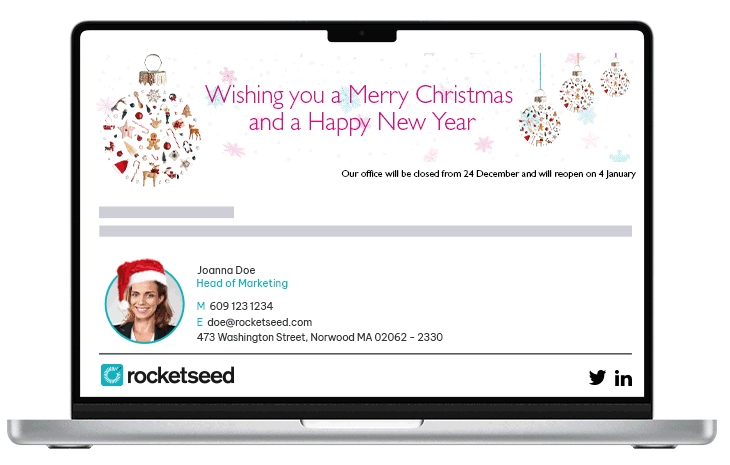
Email sign offs – vacation/annual leave
Ensure smooth communication during your absence with these tips:
- Out-of-Office Message Importance: Set a clear out-of-office message stating your vacation dates, response expectations, and contact details for urgent matters.
- Sample Out-of-Office Message: Example: “I’m away on vacation from 2025 to 2025. I will not be checking my email during this time. For urgent issues, please contact [contact details].”
- Vacation Email Sign Offs: When writing to someone about to go on vacation, use friendly sign offs like ‘Have a great time’, ‘Enjoy your break’, ‘Have a wonderful trip’, or ‘Bon voyage!’.
These tips and email sign offs help maintain effective communication while you’re away.
Email sign offs – bad news
When delivering difficult news via email, offer consolation and clarity with these sign offs:
- “I’m here for you”: Expresses support and empathy.
- “Call me whenever you want to talk”: Offers an open line of communication.
- “Please don’t hesitate to let me know if you need anything”: Shows readiness to assist.
- “Let’s talk tomorrow to work out a way forward”: Suggests a proactive approach to address the situation.
- “I understand this is difficult; take your time to process”: Acknowledges the recipient’s feelings.
- “I appreciate your understanding during this challenging time”: Recognizes the recipient’s patience and empathy.
These bad news email sign off examples help navigate delivering bad news with compassion and clarity in email communications.
Email sign offs – job application
Here’s how to sign off a job application email effectively:
- Keep it Professional: Demonstrate professionalism with sign offs like ‘Best regards’, ‘Thank you’, or ‘Thanks’.
- Show Enthusiasm: If invited to an interview, use ‘Looking forward to meeting you’.
- Avoid Presumption: Steer clear of sign offs like ‘Thanks in advance’ to avoid sounding presumptuous.
These job application email sign offs ensure you leave a positive impression on prospective employers or recruiters.
Relationship between email sign offs and email signatures
In their different ways, your email sign off and email signature both add value to your business email.
While the right email closing phrase is important for leaving the right impression and getting the right response from the recipient, a professional email signature is essential for identifying you the sender, clearly communicating your contact details and branding the email with your corporate logo. It also opens a host of marketing opportunities by enabling the recipient to click through to your website, social media profiles and key content.
Company guidelines regarding acceptable email sign offs are almost impossible to enforce. So the simplest way to ensure that all employee business emails are consistently on-brand company-wide is to control them centrally using a professional email signature manager tool.
You can also use your email sign off to draw attention to features in your signature and drive direct engagement. For example, ‘To set up an introductory meeting, simply click the ‘Book Now’ button in my signature’ or ‘You’ll find all you need on our website. Just click the link in my signature’.
So…
What’s the best way to sign off your emails?
If you are still unsure about which phrase to use to sign off an email, ask yourself the below four questions:
- What is the message of the email?
- What is the emotion that you want to convey?
- Is the email formal or informal?
- How well do you know the recipient?
Once you have answered these questions, you will be in a much better position to choose the right sign-off for every email that you send. You can also check out our 7 etiquette tips to help you write more professional emails to ensure you get every aspect of your emails just right.
Whatever email ending you choose, the easiest way to make your (and all your company’s) emails look professional is by adding a professional on-brand email signature to every email. Here at Rocketseed, we are experts in professional email signatures and can help ensure your signatures engage with your clients, generate new leads, and up-sell your products and services.
Contact us today to see how our business email signature software can revolutionize the way you sign off your emails.
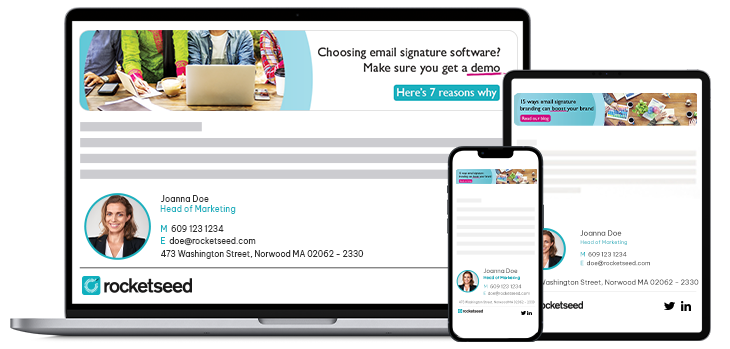
Learn about other Rocketseed features companies & corporations love:
Email Signature Management | Email Signature Marketing | Dynamic Email Banners | CRM Integration | Analytics & Reporting | Support & Service
Shanique Brophy | Marketing Executive
Connect with Shanique on LinkedIn




